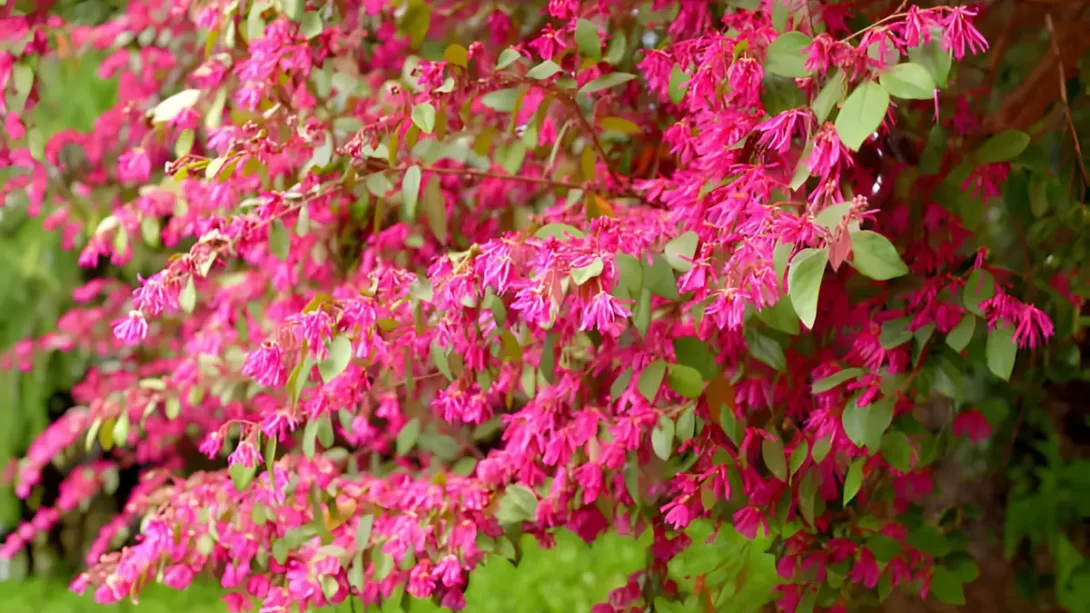Loropetalum, commonly known as Chinese Fringe Flower, is a vibrant and versatile shrub cherished in many gardens for its striking foliage and delicate, fringe-like flowers. To maintain its beauty and health, pruning is a key aspect of Loropetalum care. This guide will provide in-depth information on when and how to prune Loropetalum effectively, ensuring your shrubs remain an eye-catching feature in your landscape.
Loropetalum
Loropetalum chinense is a member of the witch hazel family, known for its unique, ribbon-like blooms and often vibrant purple foliage. The plant comes in various sizes and forms, ranging from compact shrubs to larger, tree-like varieties. Loropetalum typically blooms in early spring, with some varieties offering a second flowering in fall. The plant’s health and flowering potential are significantly enhanced by proper pruning, which can also help maintain a desired size and shape.
Identifying the Best Time to Prune Loropetalum
The best time to prune Loropetalum largely depends on its flowering cycle. Since it primarily blooms on old wood, pruning should be done soon after the spring blooming period. This timing allows the plant to set new buds for the following year without risking the loss of the current year’s flowers. In general, late spring to early summer is ideal for pruning. However, it’s important to adjust the timing based on your specific climate and the particular Loropetalum variety. In colder regions, waiting until any risk of frost has passed is crucial to avoid damage to new growth.
Preparing for Pruning
Before you start pruning your Loropetalum, it’s essential to have the correct tools. Sharp, clean pruning shears or loppers are ideal for making precise cuts, minimizing damage to the plant. For larger branches, a pruning saw may be necessary. Always clean your tools before use to prevent the spread of disease. Wear protective gloves and safety glasses for personal protection. Begin by examining your Loropetalum, identifying any dead, damaged, or diseased branches that should be removed first. Also, observe the overall shape and size of the plant to plan your pruning approach.
Pruning Techniques for Loropetalum
Pruning Loropetalum involves several key steps to ensure the health and aesthetics of the plant. Start by removing any dead or damaged branches, cutting them back to healthy wood. If the plant is overgrown or has become leggy, thin out some of the older branches to improve air circulation and light penetration. This can rejuvenate an older plant and encourage more vigorous growth. When shaping Loropetalum, aim to maintain its natural form. Avoid over-pruning, as this can reduce flowering and alter the plant’s graceful structure. For larger specimens, selective pruning of branches to create a tree-like form can be an attractive option. Always make cuts at a 45-degree angle just above a bud or branching point to encourage healthy regrowth.
Care After Pruning
After pruning, it’s important to provide proper care to your Loropetalum to support its recovery. Water the plant deeply, especially if the weather is dry, to help it recuperate from the stress of pruning. Applying a balanced, slow-release fertilizer can provide essential nutrients to promote new growth. Adding a layer of organic mulch around the base of the plant can help retain soil moisture, regulate soil temperature, and suppress weed growth. Keep an eye on the plant for signs of stress or pest infestations in the weeks following pruning. Promptly addressing any issues will help ensure your Loropetalum recovers well and remains healthy.
Seasonal Maintenance and Additional Care
Caring for Loropetalum extends beyond pruning. Throughout the growing season, ensure the plant receives adequate water, particularly during dry periods. Loropetalum prefers moist, well-drained soil but is susceptible to root rot in overly wet conditions. Monitor the soil moisture and adjust watering accordingly. During the growing season, a balanced fertilizer can promote healthy growth and flowering, but avoid late-season fertilization, which can stimulate new growth susceptible to winter damage.
Addressing Common Issues
Loropetalum is generally a hardy plant, but it can experience issues like legginess, sparse flowering, or winter damage. Legginess can often be controlled with regular pruning. If flowering is sparse, ensure the plant is getting enough sunlight and not over-fertilized, as excessive nitrogen can reduce blooming. In regions with harsh winters, protect Loropetalum with a layer of mulch and, if necessary, burlap wraps to shield it from severe cold and drying winds.
Winterizing Loropetalum
As winter approaches, it’s important to prepare Loropetalum for colder temperatures. Reduce watering as the plant enters dormancy. A layer of mulch around the base can help protect the roots from freezing temperatures. Avoid pruning in late fall or winter, as this can stimulate new growth that will be vulnerable to frost damage. In very cold climates, consider providing additional protection, such as covering the plant with burlap or a frost cloth on particularly cold nights.
Conclusion
Pruning Loropetalum effectively requires understanding its growth habits and timing your efforts to coincide with its natural cycles. By following the guidelines outlined in this article, you can help ensure your Loropetalum remains healthy, vibrant, and a beautiful addition to your garden. Remember, each plant is unique, so observe and respond to the specific needs of your Loropetalum. With these practices in place, you can enjoy the full ornamental value of this versatile shrub for many years.



